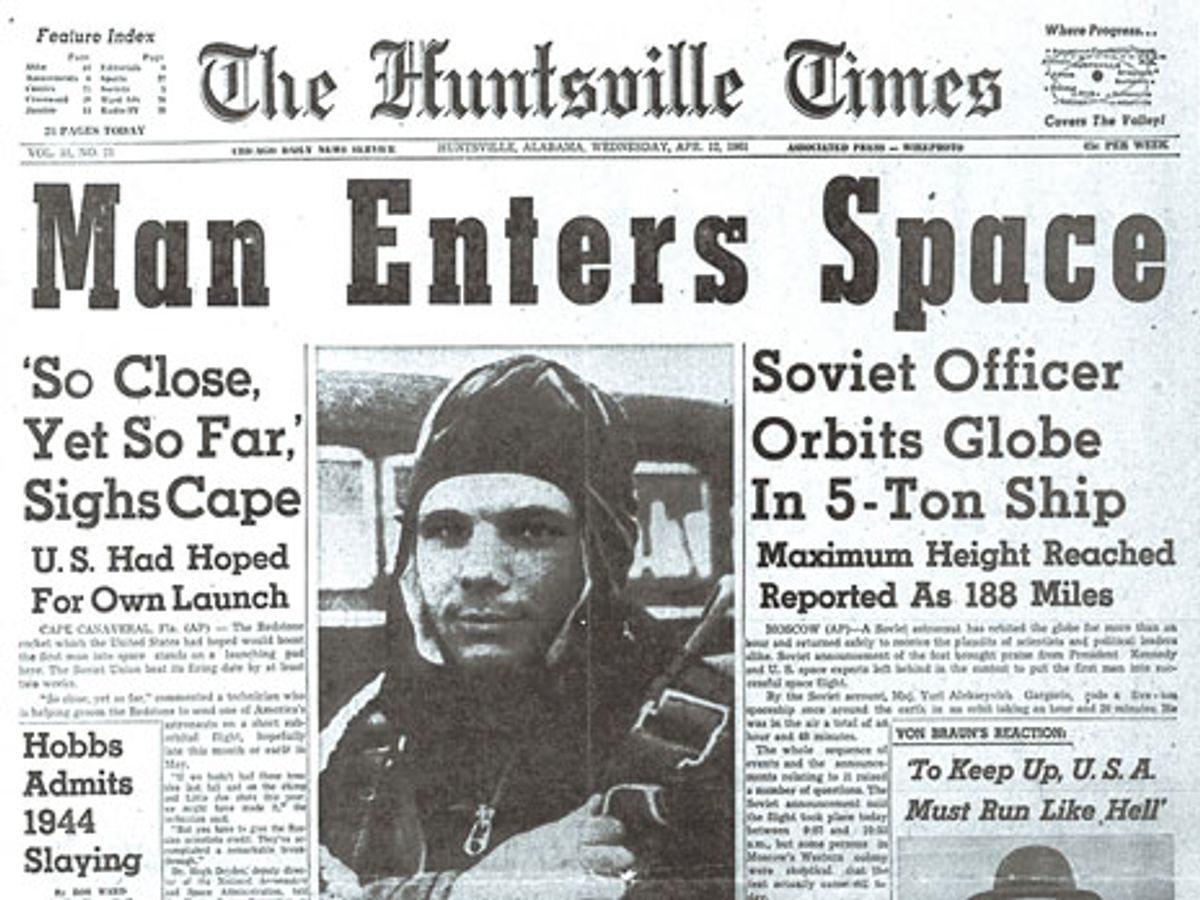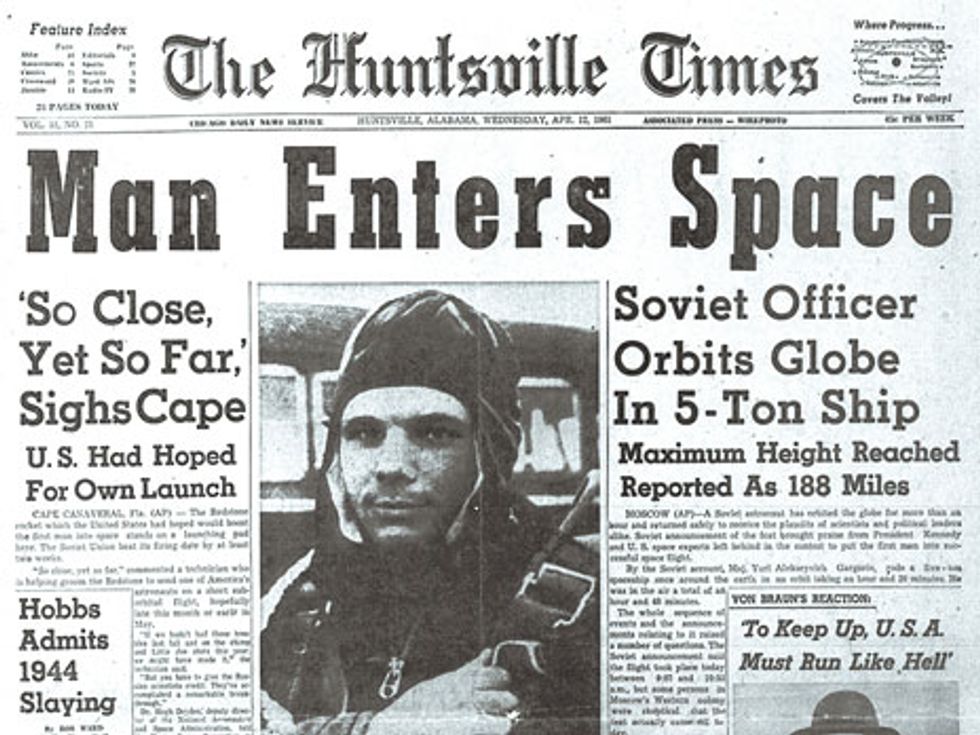11 April 2011—Tomorrow is the 50th anniversary of the first human in space—the Russian pilot Yuri Gagarin. All monumental human events attract myths, but this one especially so, as there was deep secrecy around so many fundamental aspects of the mission, and the hero died young under mysterious conditions. While we might hope for clarity in hindsight, the persistence of these popular myths makes it difficult. But one fundamental fact about Gagarin prevails and continues to resound through our culture: He was the first human who went into space—and that will always be the truth.
1. Vostok means "east" in Russian and was picked to signify dominance over the West.
Maybe, but more likely the name of Gagarin’s spacecraft was meant to express the poetic sense of the Russian root words signifying "sunrise"— vos ("upward") plus tok ("flow")—to elicit a sense of humanity rising into space. It’s a beautiful name.
2. The spacecraft was called Vostok-1.
After Vostok-2 was launched in August 1961, the previous craft, initially called Vostok, was renamed Vostok-1, and both designations have been used interchangeably for the last half century. But when the craft was first launched, it was just Vostok, no number.
3. Gagarin was "the Columbus of space."
Gagarin was often referred to this way in Soviet-era propaganda, but it inaccurately assigns him the task of obtaining funding and then organizing the expedition—a role actually played in 1961 by Sergey Korolyov. But it was Gagarin who then rode the rocket despite an array of unknown hazards, and that’s honorable enough.
4. Gagarin was picked to fly because of his solid worker or peasant origins.
Not really. But Gagarin turned out to be a perfect front man for Soviet glory. He wasn’t a very experienced pilot, but even before launch he was recognized as having an alert and flexible mind, and he wasn’t a worrier. Among the candidates he was the fastest learner and the calmest in emergencies. Being the shortest candidate, at only 1.57 meters, didn’t hurt either. Even his rivals for the first flight later admitted that he had been the right choice.
5. Gagarin was only a medical test subject, not a pilot.
The main purpose of the one-orbit flight was to demonstrate that space conditions didn’t drive a person insane or otherwise harm him, so autopilot mode was planned from the start. But Gagarin had the command codes to take manual control and was fully trained for various contingencies that would require piloting. He never had to take control, but he was trained to do so.
6. Gagarin was preceded in space by another cosmonaut, Vladimir Ilyushin.
This myth sprang up even before Gagarin went into space, and it still survives on the Internet and in occasional documentaries. Ilyushin, who died last year, was a top jet test pilot, and like so many American test pilots at the dawn of the space age, he wasn’t interested in just being "spam in a can." All new oral, photographic, and written evidence is against the idea he ever was a cosmonaut.
7. Gagarin was preceded in space by a number of earlier cosmonauts, who were all killed.
Moscow kept its program so secret, and issued so many clumsy lies about it, that almost anything was possible, especially if it eased the bruised egos of Americans tired of getting beaten in the space race. But in hindsight, not a single "secret cosmonaut" was killed in flight—although several were expelled for misbehavior, and their faces were airbrushed out of group pictures.
8. Gagarin’s mission wasn’t announced until he had safely landed so it could be covered up if it failed.
It was announced about 30 minutes before the landing. Space planners had prepared statements in advance to avoid looking scared of failure. They had even readied news releases for a fatality or off-course landing needing international rescue assistance. But after Gagarin lifted off, the official news agency in Moscow got bogged down in bureaucratic buck passing and very nearly missed getting the launch announcement out in time.
9. Cosmonaut Gherman Titov, the second man in orbit, admitted that American astronauts were braver than Soviet cosmonauts "because they have to use a rocket that flies one time and then blows up another [time], while we know Soviet rockets are perfectly safe."
Actually, in the year leading up to Gagarin’s flight, half the Russian test missions had failed in secret, enabling such phony boasts of perfection. But space karma exists. The covered-up failures were real, and rumors flourished that there had been doomed crewmen on board.
10. Two weeks before his launch, Gagarin had stood "death watch" for the fatally injured cosmonaut Valentin Bondarenko, who was dying of burns at the Botkin hospital in Moscow.
Shortly before the Vostok launch, a trainee cosmonaut named Valentin Bondarenko suffered massive burns in a fire while he was in an oxygen-rich isolation chamber. Years later, the Russian doctor who had treated him and later emigrated wrote that another military pilot had been standing watch at Bondarenko’s door while he was dying—and the doctor later recognized the face as Gagarin’s. It’s a nice story (and at first I believed it), but subsequent release of detailed cosmonaut records showed that Gagarin and all the other prime Vostok candidates were at the Baikonur launch site during that period. Their commander, General Kamanin, received news of Bondarenko’s fate while they were there and decided to withhold it so as not to depress the trainees.
11. The Vostok spacecraft was a civilian research vehicle with no military function.
From the beginning, the Vostok design was driven by the dual-use requirement of an automated vehicle that had to fly six- to eight-day orbital missions, carrying either a cosmonaut or a reconnaissance camera. The initial program funding came from the military for that purpose, and about a year after Gagarin’s flight, Vostoks carrying spy cameras began orbiting—under false cover names, of course.
12. Cosmonauts carried a poison pill in case they were captured by enemy agents, and their capsules had destruct charges to blow them up if they headed for the West, by accident or on purpose.
This garbled story was partly based on the experience of U-2 spy plane pilot Gary Powers (who declined to take his pill in his 1960 mishap). But unmanned test flights of the Vostokdid include destruct charges in the event of landing outside of the USSR, and on one mission they were actually triggered, killing the dogs on board. The KGB insisted on leaving the charges in place for manned missions, but after strenuous debate, chief designer Korolyov ordered them removed from Gagarin’s vehicle. (Incidentally, NASA’s space shuttle does have destruct charges.)
13. Two Italian brothers recorded Gagarin’s space transmissions and transmissions from other cosmonauts who vanished.
The Judica-Cordiglia brothers, who are still alive and promoting their claims, became famous in the 1960s as private space sleuths. In hindsight, none of their claims were ever verified by other radio listeners, and historians dismiss them as mistaken amateurs.
14. Gagarin reported he "didn’t see God."
Gagarin’s friend and fellow cosmonaut Aleksey Leonov recently disclosed that this phrase was conjured up by a Soviet propaganda team and that Gagarin never said it. According to Leonov, Gagarin had a personal and profound respect for religion. He had his daughters baptized and actually publicly supported a private campaign to raise funds for rebuilding the Cathedral of Christ the Savior in Moscow, which Stalin had destroyed.
15. Gagarin was nearly killed during reentry, when his capsule failed to fully unhook from the propulsion module.
The failure of the spherical crew module to cleanly separate from the equipment module just prior to hitting the atmosphere was kept secret for 40 years. The two units twirled around each other connected by cables for a minute, before aerodynamic forces snapped the connection. Such separation failures were encountered in later years as well, but each time, frictional heating and tumbling motions destroyed the connecting structure before the crew cabin hull was harmed—so it wasn’t as "nearly fatal" as it first appeared.
16. Gagarin’s flight fell short of one complete pass around Earth and thus was never officially "in orbit."
Blasting off from east of the Aral Sea and landing just east of the Volga River, the Vostok ’s flight path doesn’t seem to make a full circuit. But that’s because Earth was rotating eastward during the roughly 1.5-hour mission. In inertial space, the only frame of reference that matters in spaceflight, the Vostok completed 360 degrees and then some.
17. Gagarin didn’t deserve his flight record because he didn’t land inside his capsule.
Aviation records were recognized only if the pilot didn’t crash his vehicle. Gagarin’s parachute landing did technically violate this, and the Soviets did decide to lie about it to avoid arguments. Once it was clear that parachute descent was part of the nominal landing profile, the rules were modified to permit it.
18. The official description of Gagarin’s flight was verified by international experts.
Actually, Soviet officials filed several fraudulent claims about the flight when they sought an internationally recognized record. The location of the launch site, in latitude and longitude, was about 200 miles off. The claim that the mission duration was precisely timed by a sports commissar observing the landing with a stopwatch was also a lie—he was 200 miles from the actual landing. But these "technicalities" were brushed off in recognition of the basic truth of the flight. The lies remain in the official record, a blemish on the honor of the accomplishment.
19. Gagarin’s death in a plane crash in 1968 was his own fault.
Gagarin had returned to training in a series of flights with an instructor and was about to requalify to fly solo when he and his instructor pilot were killed in March 1968. Despite oceans of rumors, there’s no evidence he had been misbehaving, abusing drugs, or otherwise flying carelessly. Sometimes events just conspire and small flaws are magnified into catastrophes.
20. Gagarin’s death in a plane crash in 1968 was a secret assassination by Kremlin bosses.
The juiciest conspiracy theories involve Gagarin losing favor with a new regime in the Kremlin and being secretly eliminated. As with all such loony-tune theories, this requires the conspirators to have chosen the most complex error-prone sequence of events to accomplish what could easily and reliably have been performed under cover of darkness down on the ground. Soviet secrecy and a conspiracy-minded political culture have nourished such ideas for decades, so despite the recent release of more accident files, there’s probably no hope of stamping out such myths.
BONUS MYTH:
21. Gagarin’s flight was a hoax because some views show "CCCP" on his helmet and others don’t.
Gagarin’s helmet originally was pure white, but a day before launch, somebody recalled the trouble that foreign pilots shot down in spy planes had run into at the hands of the Russians who found them. To guard against a hostile welcome, the initials "CCCP" were quickly painted on Gagarin’s helmet. But earlier photos, taken without the initials, were also released.

